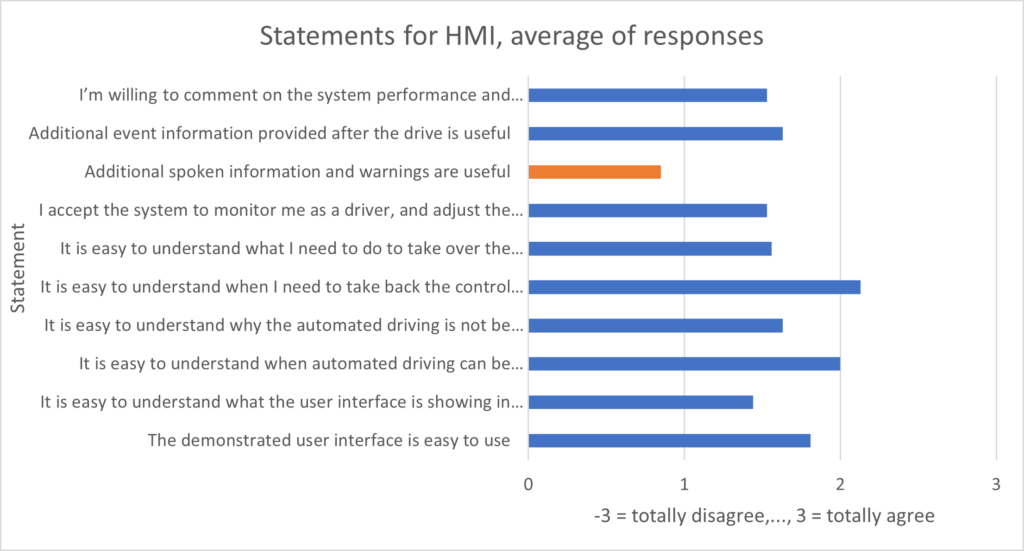The TrustVehicle project developed and demonstrated an intuitive human machine interface (HMI) for automated driving functionality of an electric city bus with professional drivers. One critical part of Automated Driving (AD) development is the HMI design. Information presented on the HMI is essential to the driver’s behaviour and therefore important to road safety.
The European research project TrustVehicle* followed a user-centric approach and provided solutions, which significantly increase reliability and trustworthiness of automated vehicles and contribute to end-user acceptance. One of the objectives of TrustVehicle was development and demonstration of intuitive human machine interface for the safe management of the transition phases between automated and human driving.
The HMI was designed by VTT together with Linkker in Finland. This was done for a city bus which drives autonomously and precisely to a charging station located at the bus stop. The same HMI design concept was also used in the project by Ford Otosan for reverse parking manoeuvre in automated driving mode of an articulated vehicle (truck trailer combination).

The TrustVehicle project has developed and demonstrated an intuitive HMI for automated driving functionality of an electric city bus with professional drivers. Photo: User_64382/Mostphotos.com
Automated driving HMI design and development process
The HMI design and development for automated driving was done in the TrustVehicle project as step-by-step process:
- Available HMI guidelines were examined and utilised later in the HMI design phase.
- Requirements for the HMI were collected from literature and derived from the user (driver) tasks analysis in selected scenarios, and the analysis of the automated driving area.
- The functionality of the automated driving and the HMI were first designed as mock-up prototypes with a multidisciplinary team including HMI and user-centered design experts as well as representatives of Linkker, who know well the professional bus drivers and their tasks in the planned scenario.
- A fully functional HMI prototype was implemented to a tablet computer that was used in evaluation with the potential users (the bus drivers of City of Tampere)
- HMI implementation and testing with 3D simulator in VTT laboratory and finally
- Actual HMI integration to the test vehicle (VTT electric bus prototype).
HMI design for professional drivers
The HMI design must conform the end user needs from the start. The bus drivers are experienced professional drivers who are trained to use the vehicle systems, including automated driving functionalities in the future. The driver will use the systems daily in their work and will likely learn relatively quickly the system functionality and its possible limitations. In the selected slow speed AD-scenario the automated drive is very short (less than 1 min). Therefore, it was decided that during automated driving the driver should monitor the system functionality and the traffic environment all the time (supported with driver monitoring system). The expertise of the professional driver would be fully utilised.
HMI evaluation with the professional bus drivers
Evaluation of the city bus automated driving HMI prototype was held with the bus drivers (from City of Tampere) in a classroom setting due to COVID-19 pandemic restrictions. The HMI prototype was introduced with videos of the automated driving functionality on the VTT’s prototype bus and fully functioning HMI mock-up with graphics, animations, and audio and speech warnings running on a tablet computer. Overall, the bus drivers were positive on the HMI prototype and the system under development. They agreed most with the statement “It is easy to understand when I need to take back the control of the vehicle”.
The least agreed statement concerned additional spoken information provided with the HMI. It was the only statement scoring less than +1 on average in scale -3 = totally disagree…, +3 = totally agree. However, the speech output was already an optional feature which users can select to use (or not) from the system settings.

Conclusions
The feedback from the professional bus drivers to the HMI prototype was very positive. The main principles of the HMI concept (such as simplified HMI, driver monitoring, driver supervising AD system and driver giving feedback after the AD drive to the system developers) was also evaluated very positively. According to the feedback, physical buttons are needed in the HMI. This was already implemented to the VTT bus: firstly, the flaps behind the steering wheel were used to activate automated driving and secondly, touching the steering wheel or use of brake pedal cancels the automated drive.
TrustVehicle has received funding from the European Union’s Horizon 2020 research and innovation programme under grant agreement No 723324.
More detailed information on the automated driving HMI for a city bus can be found from:
- TrustVehicle Final Virtual Event recording
https://www.trustvehicle.eu/final-event/ - TrustVehicle deliverables (D4.2 and D4.4)
https://www.trustvehicle.eu/downloads/public-deliverables/
Tarkiainen M., Penttinen M., Kauvo K., Sözen E., Wilbrink M., Kaup M. (2021) How Should TrustVehicles interACT?. In: Watzenig D., Schicker LM. (eds) Enhanced Trustworthiness and End User Acceptance of Conditionally Automated Vehicles in the Transition Period. Lecture Notes in Intelligent Transportation and Infrastructure. Springer, Cham.
https://doi.org/10.1007/978-3-030-60861-3_3
* Improved Trustworthiness and Weather-Independence of Conditionally Automated Vehicles in Mixed Traffic Scenarios, https://www.trustvehicle.eu/
Text: Fanny Malin, VTT
 Contact:
Contact:
Mikko Tarkiainen
mikko.tarkiainen@vtt.fi
VTT Technical Research Centre of Finland Ltd.






Follow us: